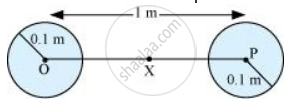Advertisements
Advertisements
Question
Two heavy spheres each of mass 100 kg and radius 0.10 m are placed 1.0 m apart on a horizontal table. What is the gravitational force and potential at the mid point of the line joining the centers of the spheres? Is an object placed at that point in equilibrium? If so, is the equilibrium stable or unstable?
Solution 1
0;
–2.7 × 10–8 J /kg;
Yes;
Unstable
Explanation:
The situation is represented in the given figure:

Mass of each sphere, M = 100 kg
Separation between the spheres, r = 1m
X is the mid point between the spheres. Gravitational force at point X will be zero. This is because gravitational force exerted by each sphere will act in opposite directions.
Gravitational potential at point X:
`=(-GM)/((r/2)) - (GM)/((r/2)) = -4(GM)/r`
`=(4xx6.67xx10^(-11)xx100)/1`
`=-2.67xx10^(-8) J/Kg`
Any object placed at point X will be in equilibrium state, but the equilibrium is unstable. This is because any change in the position of the object will change the effective force in that direction.
Solution 2
Here G = 6.67 x 10-11 Nm2 kg-2; M = 100 kg; R = 0.1 m, distance between the two spheres, d = 1.0 m
Suppose that the distance of either sphere from the mid-point of the line joining their centre is r. Then r=d/2=0.5 m. The gravitational field at the mid-point due to two spheres will be equal and opposite.
Hence the resultant gravitational field at the mid poiint = 0
The gravitational potential at the mid point = `(-"GM"/r)xx2`
= `-(6.67xx10^(-11)xx 100 xx 2)/0.5 = -2.668xx10^(-8) J kg^(-1)`
The object placed at that point would be in stable equilibrium.
APPEARS IN
RELATED QUESTIONS
A star 2.5 times the mass of the sun and collapsed to a size of 12 km rotates with a speed of 1.2 rev. per second. (Extremely compact stars of this kind are known as neutron stars. Certain stellar objects called pulsars belong to this category). Will an object placed on its equator remain stuck to its surface due to gravity? (mass of the sun = 2 x 1030 kg).
The force of attraction between two unit point masses separated by a unit distance is numerically equal to
A planet has same density and same acceleration due to gravity as of earth and universal gravitational constant G is twice of earth. The ratio of their radius:
If E and G respectively denote energy and gravitational constant, then `"E"/"G"` has the dimensions of ______.
If E and G respectively denote energy and gravitational constant, then `"E"/"G"` has the dimensions of ______.
If E and G respectively denote energy and gravitational constant, then `"E"/"G"` has the dimensions of ______.
Two identical heavy spheres are separated by a distance 10 times their radius. Will an object placed at the mid point of the line joining their centres be in stable equilibrium or unstable equilibrium? Give reason for your answer.
